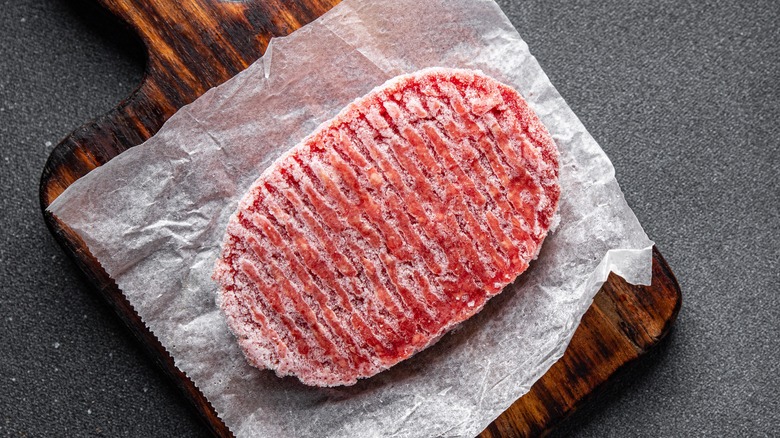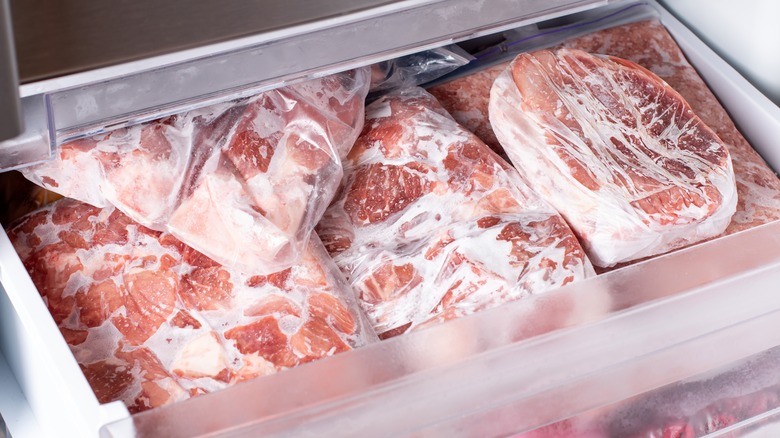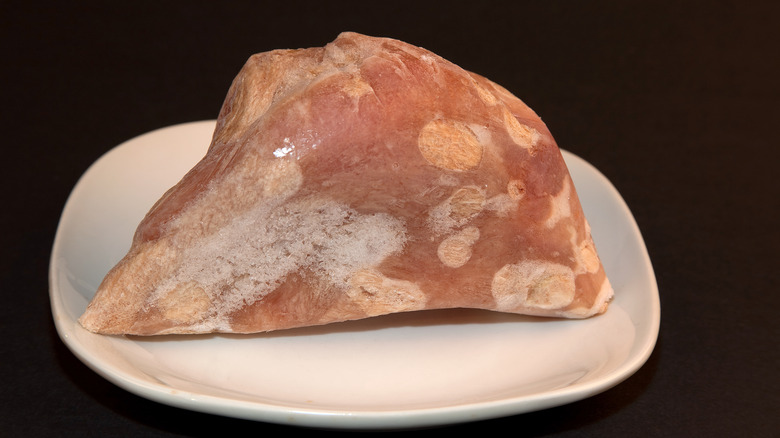Is It Safe To Eat Frozen Meat After It Expires?
Sometimes, food can get lost in the freezer. That steak, which seemed so appealing at the grocery store, might end up tucked behind ice trays, frozen vegetables, and tubs of Ben and Jerry's, forgotten long past its expiration date. When it is eventually unearthed, it can be hard to determine whether it's still safe to eat.
Fortunately, as long as meat remains frozen at zero degrees Fahrenheit or below, it will be safe to eat indefinitely — even after it's technically expired. Food contamination can occur after prolonged exposure to air and the environment. Microbial bacteria such as salmonella, E. coli, and listeria can infiltrate meat and proliferate if kept refrigerated or at room temperature. The Department of Health notes that these bacteria can cause foodborne illnesses, with symptoms including cramping, fever, and nausea. While freezing doesn't kill bacteria in meat, it does create an environment that prevents spoilage. The low temperature puts the microbes into a dormant state, halting the growth that leads to rot and foodborne illnesses.
While the food remains safe for consumption, keeping meat frozen for an extended period can lead to drawbacks in taste and texture.
Longer freezing times can affect quality and taste
Surprisingly, celebrity chef Alton Brown's perfect steak recipe starts with a frozen piece of meat, which he salts and freezes the night before cooking. However, if that steak remained in the freezer for six months, it would taste quite different. This change in taste is due to several molecular changes that occur in meat when frozen.
The first change is in the meat's ability to hold water. As water expands upon freezing, it pushes against the muscle fibers, affecting their ability to retain water once thawed. The longer meat remains frozen, the less "juicy" a steak or pork chop becomes. The second impact of freezing is fat oxidation. Most of the water in meat freezes at zero degrees Fahrenheit, but a complete freeze doesn't occur until -40 degrees Fahrenheit, a temperature unreachable by commercially available freezers. Although freezing substantially slows down oxidation, the presence of unfrozen water can lead to the breakdown and eventual rancidity of the meat's fat over time.
As a rule of thumb, raw beef and pork maintain quality for up to a year, chicken and turkey for nine months, fish and shellfish for six months, and ground meat for three to four months.
Improper storage of meat can lead to freezer burn
Even with all the facts and figures about meat storage in freezers, none of it matters if the food succumbs to freezer burn. A freezer, much like Antarctica, is a desert; it's cold and extremely dry. If cold, dry air comes into contact with food, it will dehydrate it. The result is the formation of ice crystals on the surface and patchy, discolored sections that resemble leather. While still edible, it is not going to taste good; the meat becomes bland, chewy, and generally unpleasant.
Preventing freezer burn comes down to proper packaging. While it's acceptable to freeze meats in their store packaging, using sealed, airtight containers offers additional protection against the cold air. It's now feasible to vacuum seal meat at home using relatively inexpensive machines that can fit comfortably on a countertop. Alternatively, one can follow the methods of culinary professionals like Ina Garten, who has expert advice for freezing food in containers. If it's a method endorsed by the "Barefoot Contessa" host herself, it's likely suitable for everyone.



